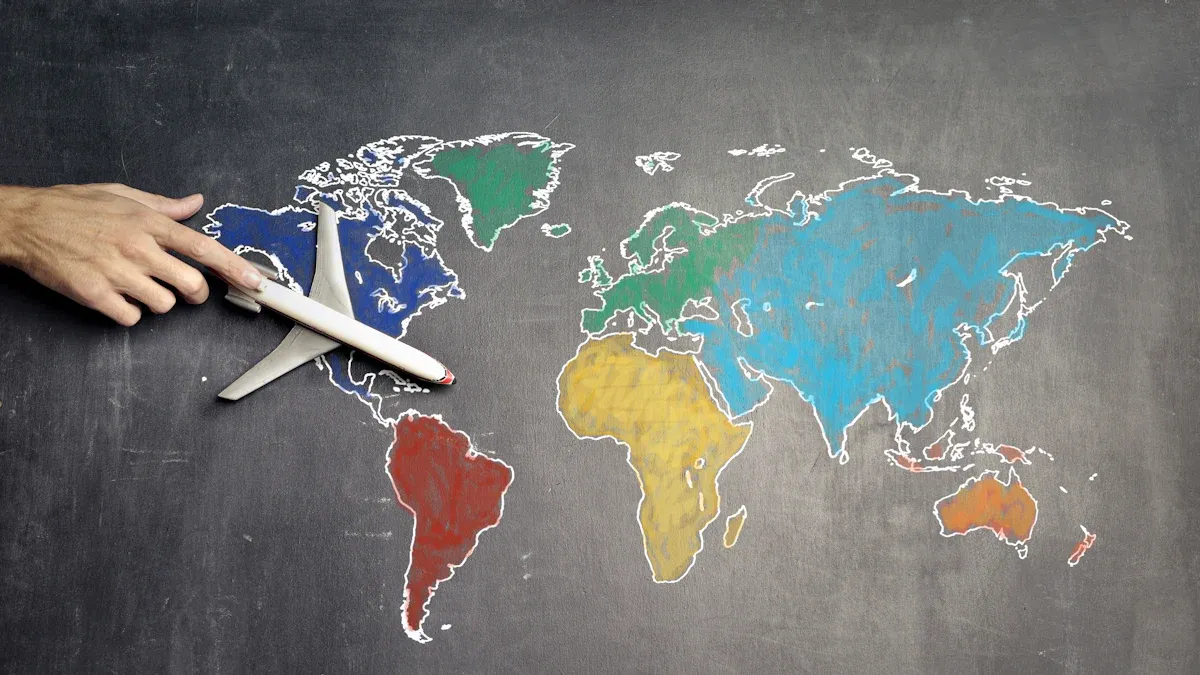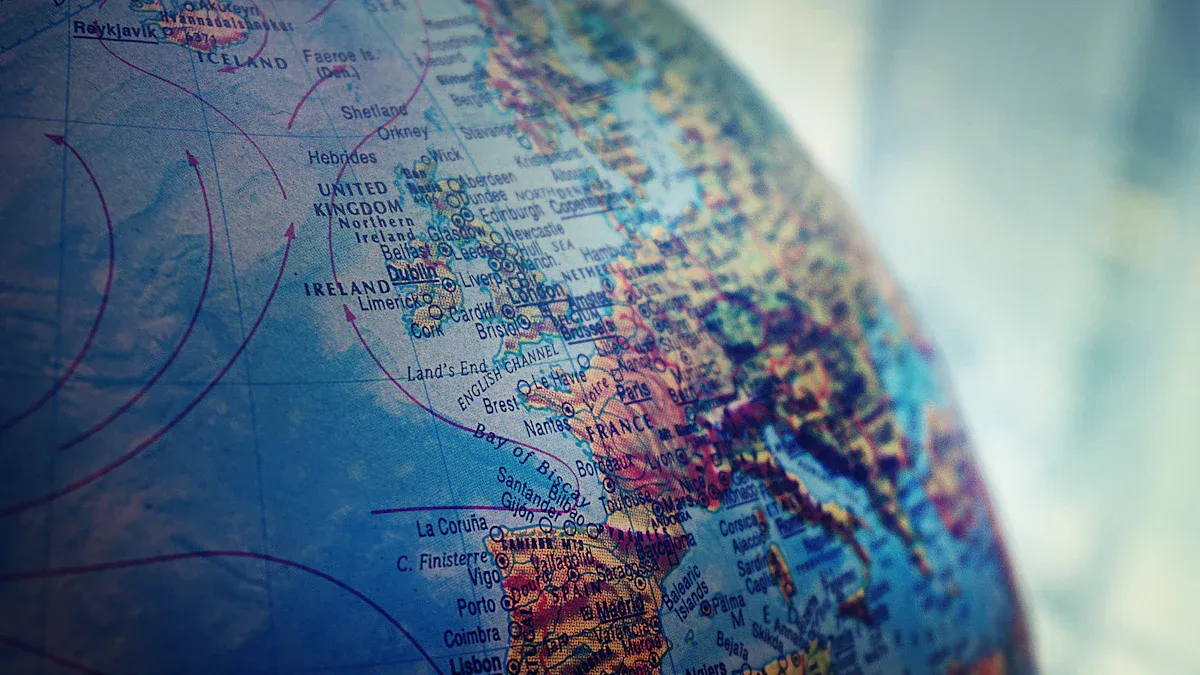
Tariffs Impact Sourcing decisions in 2025 are reshaping how you approach sourcing for plastic parts. These changes directly affect costs, availability, and the stability of supply chains. For instance, a 25% tariff on plastic imports in South Carolina could result in a total tariff bill of $168,380,231. In North Carolina, this figure reaches $166,512,281, while Texas faces an estimated $145,297,714. Such numbers highlight the growing financial burden on businesses like yours. To navigate these challenges, you must rethink your strategies, explore new suppliers, and optimize supply chains to maintain competitiveness in light of the tariffs impact sourcing.

The 2025 tariffs are expected to reshape the landscape of plastic imports. Industry analysts forecast several key changes:
- A 10% tariff on plastic resin imports from China will likely increase raw material costs for manufacturers.
- A 15% tariff on petrochemical feedstocks from the Middle East is anticipated, further driving up production expenses.
These adjustments will force you to reconsider sourcing strategies. Domestic suppliers may become more attractive as import tariffs make international options less cost-effective. However, shifting to local sources could introduce new challenges, such as limited availability or higher prices. Exploring alternative suppliers and materials will be crucial to maintaining profitability.
The impact of tariffs on costs and pricing is significant. Import tariffs directly increase the expenses associated with raw materials, which can ripple through your supply chain. For example:
| Tariff Type | Rate | Impact on Costs |
|---|---|---|
| Plastic Resin Imports from China | 10% | Cost increases of 12-20% for manufacturers |
| Petrochemical Feedstocks from Middle East | 15% | Increased costs for essential inputs |
These cost impacts leave you with tough decisions. Absorbing the additional expenses could hurt profitability, while passing them on to customers might risk losing business. Many manufacturers are prioritizing finding alternative suppliers to mitigate these challenges. Diversifying your sourcing options will help reduce dependency on regions heavily affected by tariffs.
Tariff policies vary significantly across regions, creating unique challenges for sourcing plastic parts. For instance:
- The U.S. imposes a 125% tariff on imports from China, making Chinese plastic parts prohibitively expensive.
- Recycled plastic parts face varying tariffs based on their country of origin, such as a 46% rate for recycled natural HDPE from Thailand.
- Canada and Mexico benefit from exemptions under the USMCA, making them attractive options for sourcing rPET and other materials.
These regional differences highlight the importance of understanding global trade dynamics. If you rely on imports from countries with high tariffs, you may need to shift your focus to regions with more favorable policies. Leveraging trade agreements like the USMCA can help you reduce costs and maintain supply chain stability.
Tariffs impact sourcing by creating significant supply chain disruptions. You may face challenges such as increased production costs, operational delays, and transportation bottlenecks. For example, higher tariffs on imported raw materials force you to reconfigure your supply chain. This involves identifying new suppliers in regions unaffected by tariffs, which takes time and resources. Additionally, sudden shifts in shipping routes can overwhelm ports, leading to congestion and delays.
| Impact Type | Description |
|---|---|
| Increased Production Costs | Higher costs for imported raw materials and components. |
| Supply Chain Reconfiguration | The need to identify and qualify new suppliers in non-tariffed regions. |
| Operational Delays | Time required to adjust logistics and manufacturing processes. |
| Port Congestion | Sudden shifts in shipping routes can overwhelm ports not equipped to handle increased volumes. |
| Transportation Bottlenecks | Changes in sourcing can strain existing transportation networks, leading to delays. |
| Inventory Challenges | Companies may need to stockpile goods to mitigate tariff impacts, affecting warehouse space and cash flow. |
These disruptions can also affect supply chain continuity. You may need to stockpile plastic parts to avoid shortages, which ties up cash flow and warehouse space. The impact of tariffs on logistics and manufacturing processes makes it essential to plan ahead and build resilience into your supply chain.
Tariffs on plastic imports contribute to rising costs, exacerbating the ongoing plastic crisis. Higher prices for raw materials like PET and PBT resins directly increase production expenses. This forces you to either absorb the costs or pass them on to customers. The trade war between major economies has intensified these challenges, making it harder to source affordable materials.
The plastic crisis also worsens as tariffs discourage the use of recycled materials. For instance, recycled HDPE from Thailand faces a 46% tariff, making it less competitive. This discourages sustainable practices and increases reliance on single-use plastics. As a result, plastic pollution continues to grow, creating long-term environmental and economic consequences.
The trade war has reshaped global market dynamics for plastic parts. Tariffs on petrochemical derivatives have disrupted the PET and bio-polypropylene markets. Companies like yours are adapting by localizing production and diversifying supply chains. However, these changes introduce short-term supply chain bottlenecks and increase costs.
The impact of tariffs also affects global competitiveness. Businesses in countries with high tariffs struggle to compete with those in regions offering tariff exemptions. For example, Canada and Mexico benefit from the USMCA, making them attractive sourcing options. To stay competitive, you must explore similar trade agreements and invest in innovative solutions to reduce costs.
Diversifying your suppliers and sourcing regions is one of the most effective ways to mitigate tariff risks. By working with multiple suppliers across different countries, you reduce your dependency on any single region. This approach helps you manage risks tied to global trade tensions and policy uncertainties. For example, sourcing from countries with lower tariffs can significantly cut costs. Exploring alternative sourcing options also ensures a steady supply of materials, even during geopolitical disruptions.
Monitoring policy changes and staying informed about tariff updates is equally important. This allows you to adapt quickly to new regulations and avoid operational disruptions. Leveraging data and analytics tools can help you track costs and make informed decisions. These tools also enable you to identify opportunities for cost savings and improve your sourcing strategies.
Reshoring production has become a viable solution for many businesses facing high tariffs on imported plastic parts. By bringing production back to domestic facilities, you can avoid tariffs and reduce shipping costs. This strategy is particularly effective for high-value products that require skilled labor and strict quality standards.
| Evidence | Description |
|---|---|
| Price difference | 30% of imports could be more profitably sourced domestically. |
| Rising freight costs | Increased freight costs make reshoring more attractive. |
| Economic viability | Higher tariffs and shipping costs favor domestic production over imports. |
| Supply chain concerns | Political and economic uncertainties drive companies to move production. |
| Higher-value products | Reshoring works well for complex products needing skilled labor. |
Reshoring production also strengthens your supply chain by reducing reliance on international shipping. This minimizes delays caused by port congestion or transportation bottlenecks. Additionally, reshoring aligns with sustainability goals by lowering emissions from long-distance shipping. While reshoring may involve higher initial costs, the long-term benefits often outweigh these expenses.
Using recycled materials offers a dual advantage: cost savings and environmental benefits. By incorporating recycled plastics into your production, you reduce dependency on raw materials. This lowers procurement costs and shields you from price fluctuations in the oil market, which directly impacts traditional plastic prices. For example, the packaging industry could save $7 billion annually by adopting circular principles.
Recycled materials also help you comply with regulations and avoid carbon taxes. By focusing on sustainability, you not only cut costs but also improve your brand image. This approach aligns with growing consumer demand for eco-friendly products. Leveraging recycled materials is a practical step toward reducing plastic waste while maintaining profitability.
Building a resilient and efficient supply chain is essential for navigating tariff challenges in 2025. You can take proactive steps to ensure your operations remain stable and cost-effective despite external disruptions. By focusing on adaptability and strategic planning, you can minimize risks and improve overall performance.
Working closely with suppliers helps you anticipate potential disruptions and address them before they escalate. Regular communication allows you to stay informed about changes in production capacity, pricing, or delivery schedules. For example, if a supplier faces delays due to tariffs, you can quickly adjust your sourcing strategy to avoid bottlenecks.
Tip: Establish long-term partnerships with suppliers who demonstrate reliability and flexibility. This ensures consistent access to materials like plastic, even during volatile periods.
Maintaining the right inventory levels is crucial for balancing costs and availability. Stockpiling materials may seem like a solution to tariff-related shortages, but it can tie up capital and increase storage expenses. Instead, you should use predictive analytics to forecast demand and adjust inventory accordingly.
| Inventory Strategy | Benefits |
|---|---|
| Just-in-Time (JIT) | Reduces storage costs and improves cash flow. |
| Safety Stock Management | Ensures availability during supply chain disruptions. |
| Demand Forecasting | Helps you plan inventory based on accurate predictions. |
Streamlining transportation and delivery processes reduces delays and lowers costs. You can optimize supply chain routes by analyzing shipping data and identifying the most efficient paths. Additionally, consolidating shipments minimizes freight expenses and reduces the environmental impact of transportation.
Note: Consider using digital tools to track shipments in real-time. This improves visibility and allows you to address issues like port congestion or transportation bottlenecks immediately.
Technology plays a vital role in building a resilient supply chain. Tools like AI and machine learning help you analyze data and identify trends that impact sourcing decisions. For instance, AI can predict tariff changes and recommend alternative suppliers or regions. By leveraging technology, you can make informed decisions that align with your business goals.
Sustainable practices not only reduce costs but also enhance your brand reputation. Incorporating recycled materials into your production process lowers dependency on virgin plastics and mitigates tariff impacts. Additionally, adopting eco-friendly transportation methods reduces emissions and aligns with consumer preferences for sustainable products.
Callout: Sustainability is more than a trend. It’s a strategic advantage that helps you optimize supply chain operations while meeting environmental goals.
By implementing these strategies, you can build a supply chain that withstands tariff challenges and adapts to changing market conditions. Resilience and efficiency are key to maintaining competitiveness in the evolving global trade landscape.

Artificial intelligence (AI) and predictive analytics can help you anticipate tariff changes and make informed decisions. These tools analyze historical data, market trends, and geopolitical events to forecast potential tariff adjustments. By using these insights, you can plan your sourcing strategies and avoid unexpected cost increases.
For example, AI can identify patterns in trade policies and predict when tariffs might rise or fall. This allows you to adjust your supplier contracts or stockpile materials before costs escalate. Predictive analytics also helps you evaluate the financial impact of tariffs on your supply chain. You can use this information to prioritize suppliers in regions with lower tariff risks.
Tip: Integrate AI-powered tools into your procurement process to stay ahead of tariff changes and maintain cost efficiency.
Digital tools simplify supplier and inventory management, especially during tariff-related disruptions. Platforms like Katana provide real-time visibility into your inventory levels and supplier performance. This ensures you can respond quickly to changes in demand or supply chain bottlenecks.
| Company Name | Key Achievement | Tool Used |
|---|---|---|
| Delta Development | Effortlessly stays in stock | Katana |
| Wabanaki Maple | Increases sales without hiring | Katana |
| Kron Technologies | Streamlines sales with Katana and WooCommerce | Katana |
| Peace Collective | Grew on-demand product range by 50% | Katana |
| GJ Motorsports | Saves 4 hours of weekly admin with Katana API | Katana |
| Naturewall | Doubled sales and boosted efficiency with Katana | Katana |
These tools also help you track supplier reliability and identify potential risks. For instance, if a supplier faces delays due to tariffs, you can quickly switch to an alternative source. This minimizes disruptions and ensures a steady flow of materials.
Enhanced visibility in your supply chain improves adaptability to tariff changes. Tools like Simfoni’s Spend Analytics platform provide real-time insights into tariff impacts on costs. This allows you to identify high-risk categories and make proactive sourcing decisions.
| Evidence Type | Description |
|---|---|
| Data Analytics | Improves information sharing and coordination, crucial for adapting to tariffs. |
| Case Study | Companies like Adidas use advanced technologies to manage tariff disruptions. |
| Procurement Digitalization | Enables supply chain resilience and reconfiguration in response to tariffs. |
By leveraging these tools, you can monitor your supply chain in real time and respond to disruptions effectively. This ensures your operations remain stable and competitive, even in a volatile trade environment.
Tariffs in 2025 significantly influence how you source plastic parts. They increase costs, disrupt supply chains, and reshape global market dynamics. To stay competitive, you must plan ahead and use technology to predict and manage risks effectively.
Tip: Tools like AI and analytics can help you forecast tariff changes and optimize your supply chain.
Adopting flexible strategies, such as diversifying suppliers or reshoring production, ensures resilience. By staying proactive and innovative, you can navigate these challenges and maintain a strong position in the market.
Tariffs are taxes on imported goods. They increase the cost of plastic parts by raising import expenses. This forces you to either absorb the extra costs or pass them on to customers, impacting your pricing strategy and competitiveness.
Use digital tools like supplier management platforms to analyze tariff rates by region. These tools help you compare costs and identify suppliers in countries with favorable trade agreements, ensuring cost-effective sourcing.
Tip: Regularly monitor trade policies to stay updated on tariff changes.
Reshoring works best for high-value products or when tariffs and shipping costs outweigh savings from overseas production. Evaluate factors like labor costs, infrastructure, and proximity to customers before making a decision.
Recycled materials often face lower tariffs compared to virgin plastics. By incorporating them into your production, you cut costs and meet sustainability goals. This strategy also reduces dependency on regions with high tariffs on raw materials.
Technology cannot eliminate risks but helps you manage them effectively. Tools like AI and predictive analytics forecast tariff changes, while supply chain platforms improve visibility. These solutions allow you to adapt quickly and minimize disruptions.
Note: Combine technology with strategic planning for the best results.